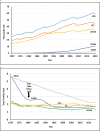Growing old in China in socioeconomic and epidemiological context: systematic review of social care policy for older people
- PMID: 37391766
- PMCID: PMC10311713
- DOI: 10.1186/s12889-023-15583-1
Growing old in China in socioeconomic and epidemiological context: systematic review of social care policy for older people
Abstract
Background: From 2020 to 2050, China's population aged ≥65 years old is estimated to more than double from 172 million (12·0%) to 366 million (26·0%). Some 10 million have Alzheimer's disease and related dementias, to approach 40 million by 2050. Critically, the population is ageing fast while China is still a middle-income country.
Methods: Using official and population-level statistics, we summarise China's demographic and epidemiological trends relevant to ageing and health from 1970 to present, before examining key determinants of China's improving population health in a socioecological framework. We then explore how China is responding to the care needs of its older population by carrying out a systematic review to answer the question: 'what are the key policy challenges to China achieving an equitable nationwide long-term care system for older people?'. Databases were screened for records published between 1st June 2020 and 1st June 2022 in Mandarin Chinese or English, reflecting our focus on evidence published since introduction of China's second long-term care insurance pilot phase in 2020.
Results: Rapid economic development and improved access to education has led to widescale internal migration. Changing fertility policies and household structures also pose considerable challenges to the traditional family care model. To deal with increasing need, China has piloted 49 alternative long-term care insurance systems. Our findings from 42 studies (n = 16 in Mandarin) highlight significant challenges in the provision of quality and quantity of care which suits the preference of users, varying eligibility for long-term care insurance and an inequitable distribution of cost burden. Key recommendations include increasing salaries to attract and retain staff, introduction of mandatory financial contributions from employees and a unified standard of disability with regular assessment. Strengthening support for family caregivers and improving smart old age care capacity can also support preferences to age at home.
Conclusions: China has yet to establish a sustainable funding mechanism, standardised eligibility criteria and a high-quality service delivery system. Its long-term care insurance pilot studies provide useful lessons for other middle-income countries facing similar challenges in terms of meeting the long-term care needs of their rapidly growing older populations.
Keywords: Ageing; China; Health equity; Social care; Systematic review.
© 2023. The Author(s).
Conflict of interest statement
Authors’ have no conflicts of interest.
Figures






References
-
- Feng Z, Glinskaya E, Chen H, Gong S, Qiu Y, Xu J, et al. Long-term care system for older adults in China: policy landscape, challenges, and future prospects. Lancet. 2020;396(10259):1362–72. 10.1016/S0140-6736(20)32136-X. - PubMed
-
- Jacques M. When China Rules the World: The End of the Western World and the Birth of a New Global Order 2nd Edition ed. London (GB): Penguin Books; 2012.
-
- Peng X. Coping with population ageing in mainland China. Asian Popul Stud. 2021;17(1):1–6. 10.1080/17441730.2020.1834197.
-
- The World Bank. GDP (constant 2015 US$) - China 2021. Accessed: 11th November 2021 [Available from: https://data.worldbank.org/indicator/NY.GDP.PCAP.KD.
-
- Curry N, Castle-Clarke S, Hemmings N. What can England learn from the long-term care system in Japan. 2018.
Publication types
MeSH terms
LinkOut - more resources
Full Text Sources
Medical

